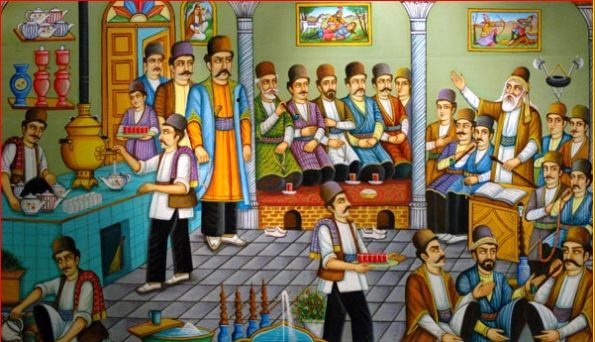History of Coffee in Iran
The history of coffee in Iran dates back to the Safavid period of the 17th century, probably a tradition borrowed from the Ottomans.
Drinking coffee seems to have been a popular habit among Iranians before tea plants were introduced and cultivated in Iran in the 19th century.
The cultivation of tea, especially in the northern regions of the country, has gradually led to the replacement of coffee. Perhaps the subtle, sweet taste of local production has won the favor of consumers over the bitterness of the expensive importation of coffee.
The old Kahveh-Khaneh, literally coffee houses, while keeping their name, now serve tea.
The traces of coffee are still to some extent preserved in some communities such as the Armenians. Likewise, certain customs continue to exist, such as offering coffee powder at funerals to share the feeling of bitterness felt during the loss of a loved one with the family of the deceased.
After the Islamic revolution, a long list of prohibitions imposed themselves on the menu of Iranian pleasures. Alcoholic beverages and narcotics such as opium are banned; coffee, although suspect in the eyes of fanatics, escapes them and is favored by it.
Iranians have always appreciated the taste of bitterness, to such an extent that in the popular language, opium, medicine for all ailments and sorrows was called “talkhi” literally bitterness, which explains the keen interest of former consumers. of opiates for coffee in Iran.
It was not until the end of the Iran-Iraq war for a relative opening of the market and the improvement of the country’s economy in order to allow Iranians to go further in the world of flavors and gustatory pleasures, once liberated. worries of war.
Coffee and its accessories find their place among imported luxury items and “Farang” souvenirs. Iranians attribute this term to everything that comes from the West in general, it is the Iranian version of the word France.
Drinking coffee is therefore timidly done in intellectual and artistic circles looking for an ally to face intellectual rather than physical fatigue, a subject of rivalry against its infused adversary, tea.
But this time, the coffee is no longer initiated in the old Kahveh-Khaneh where it was deposed a century before.
These coffee houses have given way to a novelty: the cofee-shop. A relaxed atmosphere with modern or muted decor, background music, this is where you have to pay relatively dearly for cups of this beverage, drunk by the finesse of candle light.
An ideal refuge for young singles, away from the suspicious eyes of the street to meet and discuss the thousand and one ways to drink coffee, or other things …
The reopening of Iran’s borders after the war to foreign travelers, their strong demand for coffee consumption could be a factor in the development of trade in this seed, especially in restaurants and hotels.
Gradually, players in the coffee industry are starting to learn about this product and following increasing public demand, start importing coffee beans from Brazil and other producing countries. Instead of importing the expensive European brands, local brands appear and the roasting machines are activated imitating the European model.
The Iranian palate has a preference for Robusta and Arabica flavors, and Italian espresso brands are very popular.
Filter coffee, say the third generation of coffee, is increasingly popular with those looking for more flavor and simpler preparation.
Various exhibitions are held every year in Iran, an opportunity to keep up to date with the latest trends and current events in the coffee industry.
Today, coffee has definitely found its place in the menu of pleasures as well as in the hearts of Iranians, so much so that its bitter taste has nothing to envy to the popularity of the sweetness of tea!


